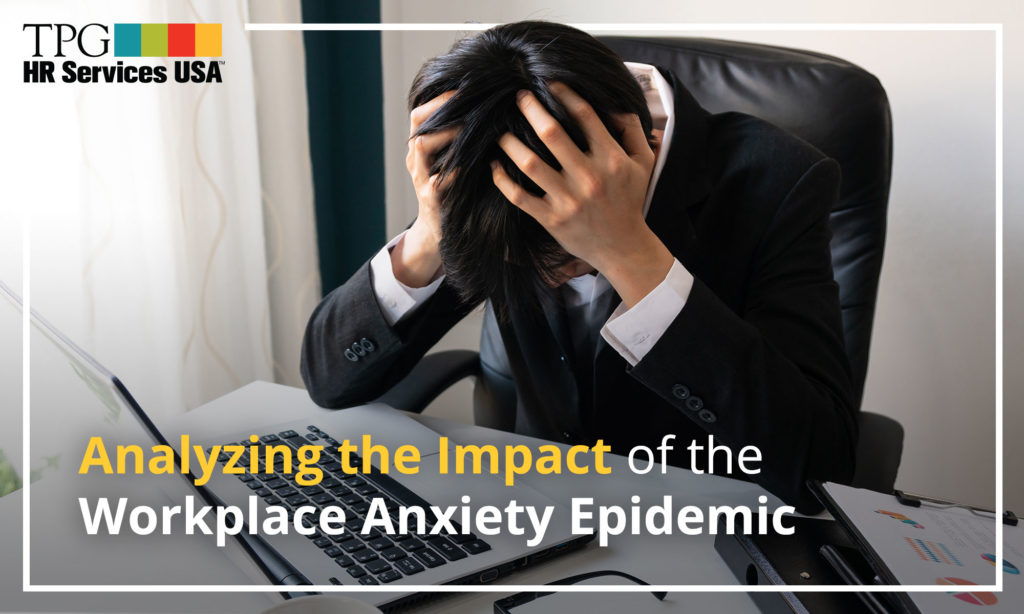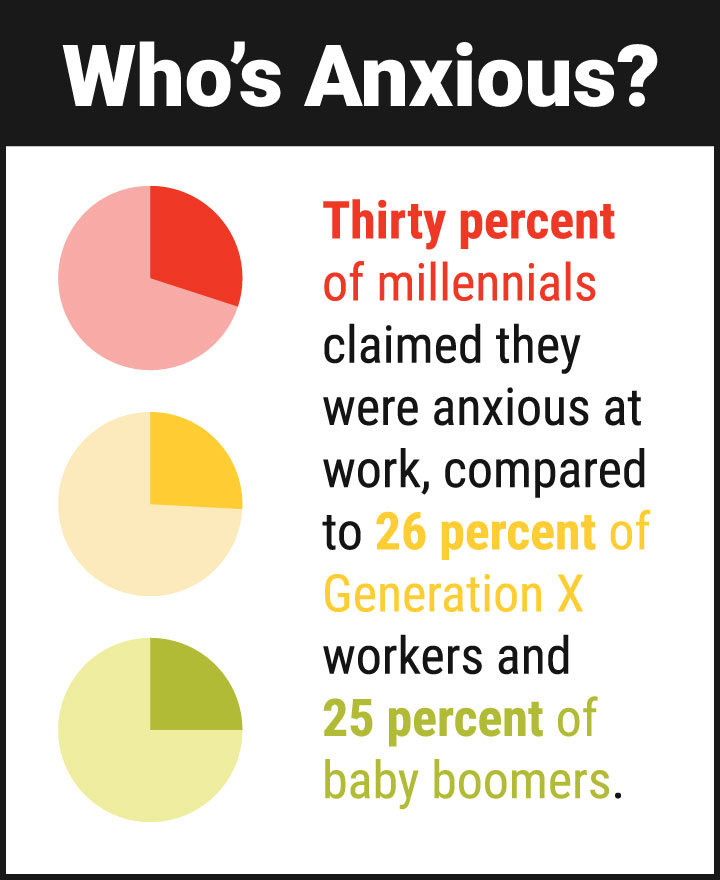
Analyzing the Impact of the Workplace Anxiety Epidemic

Ms. Pomerantz is the CEO of TPG HR Services USA and has over 35 years of Human Resources practices experience. She holds a Master’s in Human Resource Management (MHRM) and is a certified Senior Professional in Human Resources (SPHR) and SHRM Senior Certified Professional (SHRM-SCP). Mary also serves as CEO of Mary Pomerantz Advertising, one of the largest recruitment advertising agencies in the country. Earlier in her career, she was president of the 17th largest staffing firm in the country.

Anxiety disorders are the most commonly diagnosed mental illnesses in America, affecting more than 40 million adults (nearly one in five) and costing more than $42 billion in health care annually.
Stress from family life, finances, and relationships often cause people to experience feelings of anxiety, but workplace anxiety may be an overlooked issue. American culture is infamously obsessed with work – working longer hours and taking and receiving fewer vacation days than most others from wealthy nations around the world.
The World Health Organization estimates that 31 percent of the nation is dealing with anxiety disorders, which is the highest mark in the world.
The high demands of a global economy and 24/7 connectivity have made it even more difficult for Americans to take time off from work – fearing too big a loss in productivity, or workplace ramifications for not working long hours. Currently, one in nine U.S. workers is dealing with anxiety.
According to a study by researchers from the Harvard Business School and Stanford’s Graduate School of Business, the problem may be even worse than many realize. The study concluded that workplace stress may be a contributing factor in over 120,000 deaths annually, and may also contribute up to $190 billion in healthcare costs expenses. Factors such as a lack of health insurance, heavy workload, and conflicts at work are leading contributors to this growing problem.
WHO IS AFFECTED BY WORKPLACE ANXIETY MOST?
There is no one group that is completely immune to workplace anxiety, but studies show that it affects different generations and genders differently. Based on findings in a study by Besinger, DuPont & Associates, millennials (people who reached adulthood around 2000) are the most anxious group of employees in the U.S. workforce today. Thirty percent of millennials claimed they were anxious at work, compared to 26 percent of Generation X workers and 25 percent of baby boomers.

Workplace anxiety is often manifested in diminished work performance and other negative work-related consequences. The study showed that presenteeism (attending work while sick) was the top anxiety-related issue being reported, with 60 percent of participants reporting it as a concern. Absenteeism was the second most reported anxiety-related concern for employees of all ages.
In terms of the differences along gender lines, several studies have shown that women experience more anxiety than their male counterparts and are more burdened by anxiety in the workplace. The exact reasons why women are more affected by anxiety are unclear, though some research has suggested that it is a blend of biological and environmental factors.
EVERYONE FEELS ANXIETY – HOW DO YOU KNOW WHEN IT’S A PROBLEM?
Anxiety is a natural, healthy feeling that may even improve performance in certain situations. A little anxiety before a big test may make a person study harder; some nervousness and apprehension before public speaking may make a person practice more. Almost everyone experiences varying levels of anxiety on a regular basis.
Drawing the line between regular levels of anxiety and an anxiety disorder can be difficult for an untrained professional. This is one of the reasons why many anxiety disorders go untreated. Here are some examples of the difference between normal anxiety and unhealthy anxiety:
Normal Anxiety
- Concern over paying bills, finding a new job, romantic difficulties, or other life events.
- Embarrassment brought on by an awkward or uncomfortable social or professional situation.
- Nervousness before an important test, public speaking engagement, or another significant life event.
- Realistic fears, based on specific situations or dangerous objects and places.
- Sadness and difficulty sleeping in the immediate aftermath of a traumatic event or experience.
Anxiety Disorder
- Constant fear and worry that is unsubstantiated and causes significant difficulties in daily living.
- Intentional avoidance of social situations for fear of being judged and/or humiliated.
- Unexplained and random panic attacks, followed by an inescapable fear of experiencing another one.
- Baseless and irrational fears of people, places or situations that pose little or no threat to safety.
- Recurring nightmares or flashbacks correlated to traumatic experiences that date back months or even years.
THE DIFFERENCE BETWEEN ANXIETY DISORDER AND WORKPLACE ANXIETY
Not everyone who experiences workplace anxiety suffers from an anxiety disorder, though there may be some overlap. While anxiety disorders can appear at work, workplace anxiety is a separate issue and a person can experience it without having a diagnosed mental disorder or any previous history of mental health issues. This was clearly illustrated in a 2010 study investigating the link between work-related anxiety and the anxiety trait.
While a person may naturally have an anxiety condition, many anxieties are created as a direct response to a stimulus. Examples of stimuli include objects, people, places, and situations. Once the reaction of anxiety has become correlated with a specific stimulus, it becomes very difficult to break it. This is why workplace anxiety can be extremely difficult to manage.
RECOGNIZING THE SYMPTOMS OF WORKPLACE ANXIETY
No one person is fully responsible for preventing panic and anxiety attacks in the workplace – it must be a cooperative effort. Communication on the parts of the employee and employer is critical to ensuring the creation of a non-threatening work environment.
The problem that often arises is an unwillingness by employees to disclose the existence of an anxiety disorder or the development of workplace anxiety. Workers don’t want to appear as though they are being overwhelmed or that they can’t handle the work put in front of them. It’s this mentality that can eventually lead to an unfortunate panic or anxiety attack.
In an effort to mitigate this, employers need to know what to look for and need to ask questions. Workplace anxiety may manifest itself in several different ways:
- Fear of Speaking in Public
- Fear of Interacting With Authority Figures
- Workplace-Related Post-traumatic Stress
- Work Phobia
- Fear of Undertaking New Challenges
- Fear of Being Noticeably Anxious and Nervous
- Fear of Workplace Participation
- Worry About Being Overwhelmed With More Work
- Fear of Panic and Anxiety Attacks
- Social Phobia

Workplace anxiety often precipitates work absenteeism, sick leave, and early retirement. You may even see your employees turn down promotions and other opportunities for fear of being exposed to a situation that may cause anxiety. It’s highly important that managers be attuned to their staff.
HOW TO TREAT AND MANAGE WORKPLACE ANXIETY
Anxiety is often the result of a person feeling they are about to become a victim of something over which they have no control. In terms of a work environment, this includes the piling on of extra work responsibilities, sudden adjustment of performance expectations, fear of being laid off, or an inability to meet both family and work demands.
Employers and managers need to be aware of what their employees can handle, and what they’re currently dealing with and have an idea of their mental state. Most frequently, anxiety is falsely associated with a panicked person who is tense and agitated. This is far too simplistic a definition.
Symptoms of workplace anxiety can be psychological or physiological, and affect every person differently. Some may deal with a pounding heart and sweaty palms, while others may have difficulty concentrating or remembering vital information, while others may lash out at coworkers. Understanding the many symptoms and the underlying fears that induce anxiety is the key to managing it at your workplace.
Since many employees may not be upfront about their mental state, it’s up to managers to assess their work environment to see if there is anything that could cause undue stress, leading to anxiety issues.
- Are there a lot of changes happening?
- Have earnings dropped?
- Have there been recent layoffs or pay cuts?
- Are there new policies and initiatives in place which may not be employee-friendly?
- Is there something in your leadership style that may be causing anxiety?
- Do your employees have the resources they need?
- Are your employees lacking feedback or training?
- Is the workload too much?
Once you’ve identified the potential catalysts for anxiety, you should then speak to your employees to determine what they’re feeling and what you can do to improve the situation. If they see that you have a genuine concern for their wellbeing, a large portion of your employees will eventually open up – allowing you to make improvements to the work environment.
OUTSOURCED HR SERVICES MAY BE THE ANSWER
The problem many employers and managers will run into is a lack of time. If you’ve laid off employees or have taken on more work without hiring help, everyone is already most likely maxed out. An outsourced HR service provider can pick up the slack in the areas of employee relations and communications to help ensure that your workplace atmosphere remains as employee-friendly as possible.
TPG HR Services USA is an established leader and authority in the world of human resources and employee management. We have helped countless businesses of all sizes improve employee morale and employee retention. Contact us today at 732-917-6000 to learn more about our many HR services and how we can help your business succeed.
